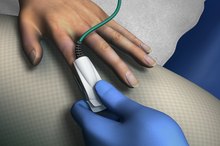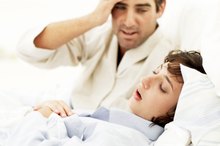Causes of Shortness of Breath When Lying Down
Shortness of breath while laying down -- a symptom medical professionals call orthopnea -- is concerning as it often suggests the presence of a serious underlying disease. Orthopnea can result from disorders of the heart, lungs and gastrointestinal system. It can also occur with obesity. All orthopnea requires a thorough medical evaluation, but rapid-onset orthopnea merits emergency medical attention.
Congestive Heart Failure
The heart pumps oxygen-rich blood from your lungs to your body. Any condition that impairs the heart's pumping function can cause a condition called congestive heart failure, or CHF. With CHF, spaces in the lungs that are normally filled with air become congested with blood, causing fluid leakage into these areas. This causes shortness of breath. Shortness of breath resulting from CHF may worsen when lying flat because blood that pools in your legs while upright puts extra strain on the heart when you lie down. The strain worsens the heart's pumping function and leads to extra fluid backup in the lungs.
Many heart conditions can lead to CHF, but the most common are coronary artery disease, high blood pressure and disorders of the structure or function of your heart valves. Less commonly, a viral infection, chronic alcoholism or inherited diseases can cause CHF.
- The heart pumps oxygen-rich blood from your lungs to your body.
- Many heart conditions can lead to CHF, but the most common are coronary artery disease, high blood pressure and disorders of the structure or function of your heart valves.
Asthma
Obesity & Wheezing
Learn More
A number of lung conditions can cause shortness of breath that worsens when lying down. Some people with asthma experience symptoms primarily at night, and notice shortness of breath when lying down to sleep. The reasons for these nighttime symptoms are debated, but shortness of breath at night may indicate undiagnosed asthma. If asthma has already been diagnosed, nighttime shortness of breath may indicate a need to change the timing of when asthma medications are taken so they are more effective at night.
- A number of lung conditions can cause shortness of breath that worsens when lying down.
- The reasons for these nighttime symptoms are debated, but shortness of breath at night may indicate undiagnosed asthma.
COPD
Chronic obstructive pulmonary disease, or COPD, is a chronic lung disease usually caused smoking. COPD is also characterized by acute episodes of shortness of breath, wheeze, and cough, which is often productive of sputum. As in asthma, during acute COPD exacerbations patients may complain of orthopnea, and may assume a "tripod" position, sitting up and leaning forward with their hands on their knees, in order to relieve their breathlessness.
Gastrointestinal Conditions
Causes of Low Blood Oxygen Levels
Learn More
Gastroesophageal reflux disease, or GERD, is another cause of orthopnea. In GERD, acid from the stomach backs up into the esophagus. This often causes the characteristic heartburn that GERD sufferers complain of. If the stomach acid refuxes into your trachea, it can produce cough and a sensation of shortness of breath. Because reflux is more likely to occur when laying flat, GERD can be a cause of orthopnea (Harrison's, Ch 2. 33: Dyspnea; Approach to the Patient: Dyspnea).
- Gastroesophageal reflux disease, or GERD, is another cause of orthopnea.
- If the stomach acid refuxes into your trachea, it can produce cough and a sensation of shortness of breath.
Obesity
Obesity is associated with a variety of changes in the normal physiology of respiration, including smaller lung volumes and an increased effort required to generate a normal rate and depth of ventilation. Obesity is also associated with shortness of breath, which is typically worse when laying flat. This is because in order to breath, your diaphragm, the principle muscle of respiration, must compress your abdominal contents in order to expand your lungs. When standing erect, your abdominal contents hang low in your abdomen, and they are easily compressible. When laying flat, your abdominal contents redistribute, causing a greater degree of mechanical obstruction for the diaphragm. (Harrison's, Ch 2. 33: Dyspnea; Approach to the Patient: Dyspnea).
- Obesity is associated with a variety of changes in the normal physiology of respiration, including smaller lung volumes and an increased effort required to generate a normal rate and depth of ventilation.
- When laying flat, your abdominal contents redistribute, causing a greater degree of mechanical obstruction for the diaphragm.
- (
Warnings
All orthopnea needs to be evaluated by a medical professional. However, if you are experiencing orthopnea that has developed or progressed rapidly, seek emergency care as this may indicate a life-threatening problem.
Related Articles
References
- Tintinalli's Emergency Medicine: A Comprehensive Study Guide, Seventh Edition; Judith Tintinalli, M.D., et al.
- Harrison's Principles of Internal Medicine, Eighteenth Edition; Dan L. Longo, M.D., et al.
- CURRENT Diagnosis & Treatment in Pulmonary Medicine; Michael E. Hanley, M.D., and Carolyn H. Welsh, M.D.
- DeGowin's Diagnostic Examination, Ninth Edition; Richard F. LeBlond, M.D., et al.
- Ekundayo OJ, Howard VJ, Safford MM. Value of orthopnea, paroxysmal nocturnal dyspnea, and medications in prospective population studies of incident heart failure. Am J Cardiol. 2009;104(2):259–264. doi:10.1016/j.amjcard.2009.03.025
- Mukerji V. Dyspnea, Orthopnea, and Paroxysmal Nocturnal Dyspnea. In: Walker HK, Hall WD, Hurst JW, editors. Clinical Methods: The History, Physical, and Laboratory Examinations. 3rd edition. Boston: Butterworths; 1990. Chapter 11.
- Lala A, Mcnulty SE, Mentz RJ. Relief and Recurrence of Congestion During and After Hospitalization for Acute Heart Failure. Circulation: Heart Failure. 2015;8(4):741-748. doi:10.1161/circheartfailure.114.001957
- Ganong WF. Respiratory Adjustments in Health and Disease. In: Review of Medical Physiology, 12th ed. Los Altos: Lange Medical Publications, 1985;558–71.
- Thibodeau JT, Turer AT, Gualano SK, et al. Characterization of a Novel Symptom of Advanced Heart Failure: Bendopnea. JACC Heart Fail 2014; 2:24–31.
- Yancy CW, Jessup M, Bozkurt B, et al. 2013 ACCF/AHA Guideline for the Management of Heart Failure: Executive Summary: a Report of the American College of Cardiology Foundation/American Heart Association Task Force on practice guidelines. Circulation 2013; 128:1810.
Resources
Writer Bio
I hold a Master's degree in exercise physiology/health promotion. I am a certified fitness specialist through the American College of Spots Medicine and an IYT certified yoga teacher. I have over 25 years experience teaching classes to both general public and those with chronic illness. The above allows me to write directly to the reader based on personal experiences.








